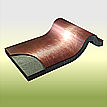
Copper plating is a phase in chromium plating of plastics. It is also used for decoration.
Tin (Sn) is used to plate steel components already coated by nickel or copper, against corrosion; steel plates for the conservation industry; for improving the solderability of surfaces in the electronic industry. Basic and acid electrolytes are used.
Danish Name
Category
Materials
Copper
Tin
Substrates for copper:
Zinc (Zn)
Aluminium (Al)
Magnesium (Mg)
Plastics
Substrate for tin:
Steel
Copper & nickel plated parts
Typical products
Washer (Sn)
Water tap (Cu)
ReferencesGalvanisk Kompagni A/S
Price notes
| DKK/part | 5 parts | 100 | 5000 |
| Small (1cm2) | 84 / 84 / 84 | 11 / 11 / 11 | 0.083 / 0.18 / 0.069 |
| Medium (1dm2) | 117 / 127 / 116 | 22 / 32 / 21 | 0.71 / 1.65 / 0.55 |
| Large (100dm2) | 276 / 510 / 240 | 159 / 392 / 122 | 58 / 151 / 42 |
Price date
Environmen- tal notes
Disposal: Both tin and copper can cause problems when recycling steel.
Additional info
Photo
Copyright
This page is part of Design inSite
Disclaimer